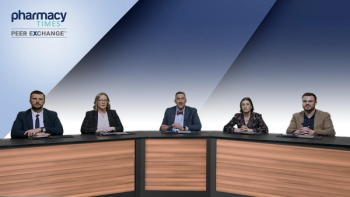Dan Landup, PharmD, HF-Cert
Articles by Dan Landup, PharmD, HF-Cert

Future Considerations for the Management of Hyperlipidemia
ByCraig Beavers, PharmD, FACC, FAHA, FCCP, BCCP, BCPS-AQ Cardiology, CACP ,Kelsey E. Norman, PharmD, BCCP, BCACP, BCPS,Dan Landup, PharmD, HF-Cert ,Katherine DiPalo, PharmD,Ralph J. Riello, PharmD, BCPS Panelists discuss how anticipated updates to cholesterol guidelines and related cardiovascular-kidney-metabolic health (CKM) guidelines this year are expected to shape low-density lipoprotein cholesterol (LDL-C) management strategies and influence treatment recommendations for high-risk patients.

Additional Considerations for LDL-C–Lowering Therapies
ByCraig Beavers, PharmD, FACC, FAHA, FCCP, BCCP, BCPS-AQ Cardiology, CACP ,Kelsey E. Norman, PharmD, BCCP, BCACP, BCPS,Dan Landup, PharmD, HF-Cert ,Katherine DiPalo, PharmD,Ralph J. Riello, PharmD, BCPS Panelists discuss how key clinical and economic factors, such as efficacy, safety, cost-effectiveness, patient adherence, and proper monitoring, should be considered when evaluating new low-density lipoprotein cholesterol (LDL-C)–lowering medications for formulary inclusion, and how health care teams can optimize therapy management through patient counseling, monitoring, and coordination of injection therapies to improve outcomes.

Monitoring Patients for Adverse Events and Optimizing Access to Therapies
ByCraig Beavers, PharmD, FACC, FAHA, FCCP, BCCP, BCPS-AQ Cardiology, CACP ,Kelsey E. Norman, PharmD, BCCP, BCACP, BCPS,Dan Landup, PharmD, HF-Cert ,Katherine DiPalo, PharmD,Ralph J. Riello, PharmD, BCPS Panelists discuss how ongoing monitoring and individualized treatment adjustments can help mitigate adverse events associated with low-density lipoprotein cholesterol (LDL-C)–lowering therapies while maintaining efficacy and explore strategies to navigate insurance barriers and ensure timely access to nonstatin LDL-C–lowering medications.

Patient Education for LDL-C–Lowering Therapies
ByCraig Beavers, PharmD, FACC, FAHA, FCCP, BCCP, BCPS-AQ Cardiology, CACP ,Kelsey E. Norman, PharmD, BCCP, BCACP, BCPS,Dan Landup, PharmD, HF-Cert ,Katherine DiPalo, PharmD,Ralph J. Riello, PharmD, BCPS Panelists discuss how patient education should emphasize the importance of low-density lipoprotein cholesterol (LDL-C) management, the benefits and risks of therapy intensification, and how clinicians can navigate the expanding range of LDL-C–lowering agents by considering patient-specific factors such as cardiovascular risk, prior treatments, and cost-effectiveness.

Identifying Nonadherence in Patients With Hyperlipidemia
ByCraig Beavers, PharmD, FACC, FAHA, FCCP, BCCP, BCPS-AQ Cardiology, CACP ,Kelsey E. Norman, PharmD, BCCP, BCACP, BCPS,Dan Landup, PharmD, HF-Cert ,Katherine DiPalo, PharmD,Ralph J. Riello, PharmD, BCPS Panelists discuss how clinical teams can identify and address nonadherence to statin and nonstatin therapies by leveraging electronic health record (EHR) systems for adherence monitoring and optimizing patient outcomes.

Optimizing Treatment of Patients on LDL-C–Lowering Therapies
ByCraig Beavers, PharmD, FACC, FAHA, FCCP, BCCP, BCPS-AQ Cardiology, CACP ,Kelsey E. Norman, PharmD, BCCP, BCACP, BCPS,Dan Landup, PharmD, HF-Cert ,Katherine DiPalo, PharmD,Ralph J. Riello, PharmD, BCPS Panelists discuss how health care teams can ensure patients remain on optimal low-density lipoprotein cholesterol (LDL-C)–lowering therapy by leveraging collaborative strategies, facilitating therapy intensification, and incorporating essential components into shared decision-making tools to personalize treatment plans.

Deciding Between Novel, Nonstatin Therapies
ByCraig Beavers, PharmD, FACC, FAHA, FCCP, BCCP, BCPS-AQ Cardiology, CACP ,Kelsey E. Norman, PharmD, BCCP, BCACP, BCPS,Dan Landup, PharmD, HF-Cert ,Katherine DiPalo, PharmD,Ralph J. Riello, PharmD, BCPS Panelists discuss how medical professionals consider PCSK9 inhibitors, bempedoic acid, and inclisiran in various clinical scenarios, their experiences with these newer therapies, the implications of the INCEPTION trial for treating patients with high-risk cardiovascular disease—particularly those who are statin-intolerant—the urgency of postcoronary event treatment, and emerging data on the broader impact of low-density lipoprotein cholesterol (LDL-C)–lowering therapies on quality of life.

Clinical Value of Nonstatin Therapies
ByCraig Beavers, PharmD, FACC, FAHA, FCCP, BCCP, BCPS-AQ Cardiology, CACP ,Kelsey E. Norman, PharmD, BCCP, BCACP, BCPS,Dan Landup, PharmD, HF-Cert ,Katherine DiPalo, PharmD,Ralph J. Riello, PharmD, BCPS Panelists discuss how evidence from a value-based care perspective demonstrates long-term health benefits, including reduced recurrent events and hospitalizations, as well as cost savings associated with intensive low-density lipoprotein cholesterol (LDL-C)–lowering therapies beyond statins in patients who are very high-risk post-atherosclerotic cardiovascular disease (ASCVD), while also addressing key challenges health care providers face in selecting nonstatin therapies and strategies to overcome them.

Cost and Safety of Novel, Nonstatin Therapies
ByCraig Beavers, PharmD, FACC, FAHA, FCCP, BCCP, BCPS-AQ Cardiology, CACP ,Kelsey E. Norman, PharmD, BCCP, BCACP, BCPS,Dan Landup, PharmD, HF-Cert ,Katherine DiPalo, PharmD,Ralph J. Riello, PharmD, BCPS Panelists discuss how patients' access to and preferences for PCSK9 inhibitors and other treatments are influenced by factors such as insurance coverage, administration convenience, financial toxicity, and individual health concerns.

Mechanisms of Action of Nonstatin Therapies
ByCraig Beavers, PharmD, FACC, FAHA, FCCP, BCCP, BCPS-AQ Cardiology, CACP ,Kelsey E. Norman, PharmD, BCCP, BCACP, BCPS,Dan Landup, PharmD, HF-Cert ,Katherine DiPalo, PharmD,Ralph J. Riello, PharmD, BCPS Panelists discuss how PCSK9 inhibitors, bempedoic acid, and inclisiran lower low-density lipoprotein cholesterol (LDL-C) through distinct mechanisms—PCSK9 inhibitors enhance LDL receptor recycling, bempedoic acid inhibits ATP citrate lyase to reduce cholesterol synthesis, and inclisiran uses RNA interference to decrease PCSK9 production—comparing their efficacy in reducing recurrent cardiovascular events.

Effective Approaches for Utilizing Nonstatin Therapies
ByCraig Beavers, PharmD, FACC, FAHA, FCCP, BCCP, BCPS-AQ Cardiology, CACP ,Kelsey E. Norman, PharmD, BCCP, BCACP, BCPS,Dan Landup, PharmD, HF-Cert ,Katherine DiPalo, PharmD,Ralph J. Riello, PharmD, BCPS Panelists discuss how medical professionals navigate statin initiation, considering contraindications or delays in specific patient populations, including those with liver disease or renal impairment, older adults, and other high-risk groups, while also examining evolving treatment patterns and factors influencing the adoption of more intensive low-density lipoprotein cholesterol (LDL-C)–lowering therapies.

Important Treatment Considerations With LDL-C– Lowering Therapies
ByCraig Beavers, PharmD, FACC, FAHA, FCCP, BCCP, BCPS-AQ Cardiology, CACP ,Kelsey E. Norman, PharmD, BCCP, BCACP, BCPS,Dan Landup, PharmD, HF-Cert ,Katherine DiPalo, PharmD,Ralph J. Riello, PharmD, BCPS Panelists discuss how the initiation of statin therapy requires careful consideration of contraindications and patient-specific factors, particularly in those with liver disease, renal impairment, or advanced age, while noting evolving treatment patterns toward more intensive low-density lipoprotein cholesterol (LDL-C)–lowering therapies based on individualized risk assessment.

Weighing the Benefits and Risks of Statin Therapy
ByCraig Beavers, PharmD, FACC, FAHA, FCCP, BCCP, BCPS-AQ Cardiology, CACP ,Kelsey E. Norman, PharmD, BCCP, BCACP, BCPS,Dan Landup, PharmD, HF-Cert ,Katherine DiPalo, PharmD,Ralph J. Riello, PharmD, BCPS Panelists discuss how statin therapy for primary prevention requires careful consideration of cardiovascular risk factors against potential adverse effects such as myalgia and liver abnormalities, generally favoring treatment when the calculated 10-year atherosclerotic cardiovascular disease [ASCVD] risk exceeds 7.5% to10% and adjusting recommendations based on individual patient factors including age, comorbidities, and preferences.

Guideline Recommendations for LDL-C Management
ByCraig Beavers, PharmD, FACC, FAHA, FCCP, BCCP, BCPS-AQ Cardiology, CACP ,Kelsey E. Norman, PharmD, BCCP, BCACP, BCPS,Dan Landup, PharmD, HF-Cert ,Katherine DiPalo, PharmD,Ralph J. Riello, PharmD, BCPS Panelists discuss how evolving clinical guidelines for intensive low-density lipoprotein cholesterol (LDL-C)–lowering therapies have shaped personalized treatment approaches through risk stratification, with different targets for primary vs secondary prevention and consideration of genetic factors when determining appropriate statin intensity.

Target LDL-C Levels for Patients
ByCraig Beavers, PharmD, FACC, FAHA, FCCP, BCCP, BCPS-AQ Cardiology, CACP ,Kelsey E. Norman, PharmD, BCCP, BCACP, BCPS,Dan Landup, PharmD, HF-Cert ,Katherine DiPalo, PharmD,Ralph J. Riello, PharmD, BCPS Panelists discuss how cardiology practice has evolved toward more aggressive low-density lipoprotein cholesterol (LDL-C)–lowering strategies across specialties, with current guidelines generally recommending targets below 70 mg/dL for high-risk patients and even lower thresholds (below 55 mg/dL) for very high-risk individuals, though these targets require personalization based on age, comorbidities such as diabetes and hypertension, and other cardiovascular risk factors.








